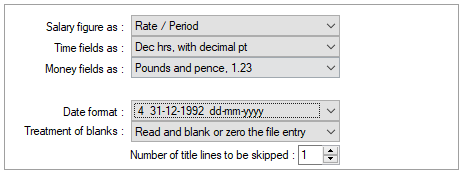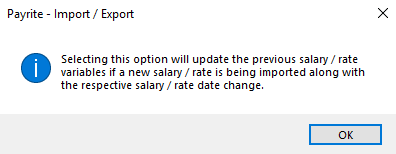Creating Salary Change Imports
Salary change imports in IRIS Payrite automatically move the existing salary details into the Previous Hours and Salary section on the base data screen.

This will then be used to pro-rata the salary when the payrun is opened. This also works when importing multi-post salary changes.
You should ideally import salary changes before the payrun is opened. If you import them into an open run, you may need to recalculate the payrun.
-
Click on the Import / Export icon.
-
Click the + button or double-click on New Layout.
-
Name the template to something you can easily recognise.

-
Set the parameters for file type according to the format of the file you are importing.

-
Check the Does CR or LF end record? box and set the Inverted Commas to Around Text Fields.

-
Set the Date Format and Time fields as fields to match the formats in your import file.
These will be date format 4 for DD/MM/YYYY format dates and Dec hrs with decimal point for hours fields expressed as decimal.

Set the Treatment of Blanks option to Read and blank or zero the file entry, then set the Number of title lines to be skipped to reflect the amount of header lines in your import file.
The Salary Fields As setting is important in this import. You should select Rate / Period if you are importing the annual salary (IRIS Payrite will calculate the period salary) and you should choose Rate / Annum if you are importing the period salary (IRIS Payrite will calculate the annual salary).
You do not need to specify all salary fields, just the annual or period salary, plus the contracted hours.
-
Tick the Salary Change Import box.

-
Click OK at the prompt.

-
This information box is there to give information about what the setting does. Go to the Variables Layout tab.

-
Set the Base file to Employee and Coded file type to Non coded.
-
Map the fields on the import file into the template. Remember, if you do not need to import a field, you should use field numbers of 1 or 3 to ignore them.

-
If you want IRIS Payrite to pro-rata the salary changes, you should make sure that the effective date is present in the data. You can map this to the template using the field number 1010 Salary Changed.

-
If you are changing the rates (i.e the overtime rate, hourly rate and / or daily rate) on a different date, you can import this into the field 1470 Rates Changed.
When importing for salaried employees, you cannot import an hourly rate as it is calculated automatically. You should therefore import contracted hours (field 960 Basis Hours) if you would like the hourly rate to be calculated.
-
Make sure you map out every field on the import file, even if you are just ignoring the column. This will help to eliminate errors when you run the import.
-
Click Save when you have finished.